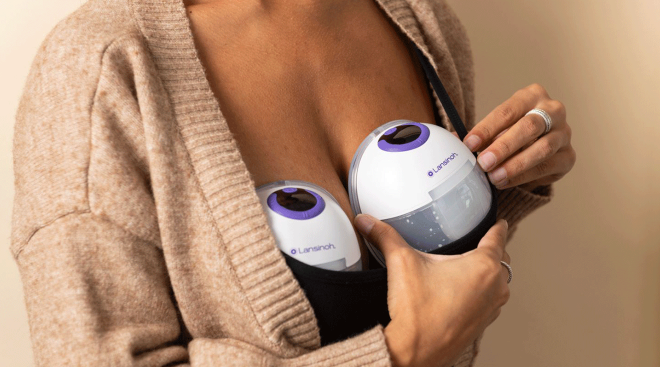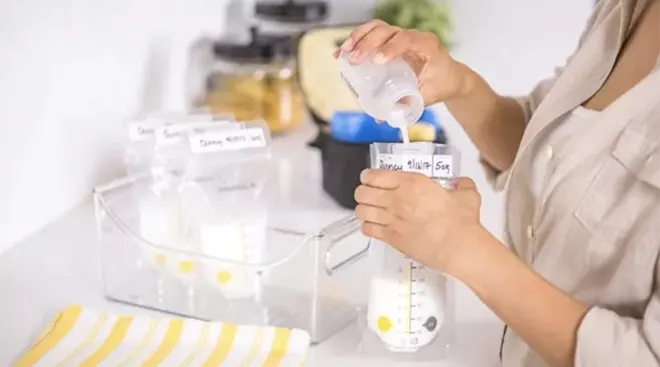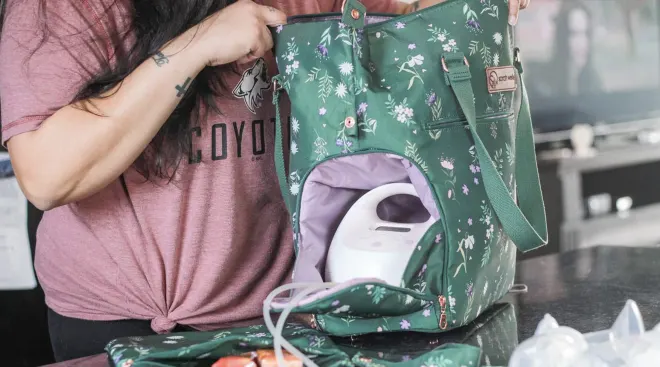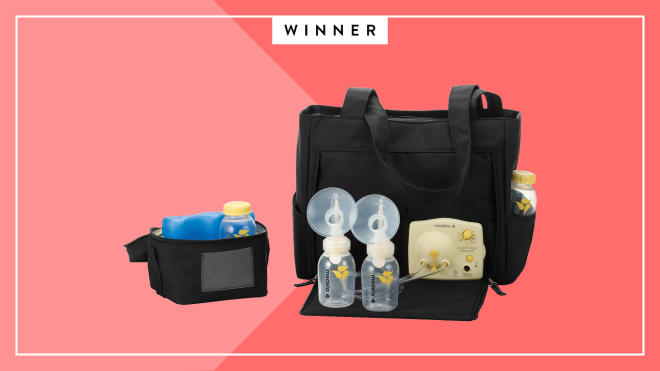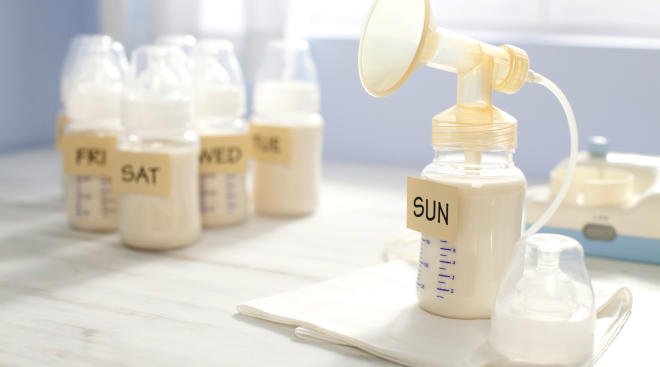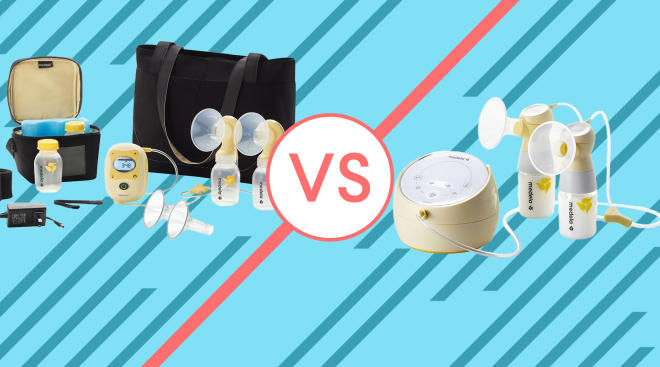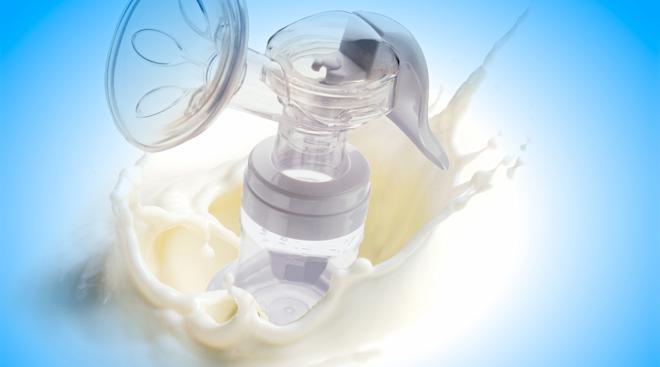21 Breast Pumping Tips to Get You Through the Day
Whether you’re regularly pumping at work, exclusively pumping or occasionally pumping to prepare for a much-needed night out, the experience can be confusing, annoying and downright uncomfortable. But it doesn’t have to be! Learning how to use a breast pump and tapping friends and experts for their best breast pumping tips can make pumping breast milk no big deal. But as a new mom, we’re guessing you’re a little short on time. So we talked to lactation experts and new moms to round up the smartest time-saving pumping hacks to help make your pumping session as productive and (dare we say) pleasant as possible.
• Get a pump before baby arrives. Under the Affordable Care Act, a lot of insurance plans will provide a free breast pump or charge a small co-pay. Find out what yours offers, what breast pump models it covers and how to get one, since sometimes pumps need to be purchased from specific suppliers. Getting your equipment squared away before baby comes is a smart way to minimize your new-mom stress.
• Understand your breast pump options. Depending on your needs and preferences, different pumps will suit different women—so one of the best breast pumping tips we can offer is to get a sense of what kind of pumps are out there and what various pump terms mean. The biggie: closed system vs. open system. “A closed system has a barrier between the pump mechanism and the milk collecting system,” explains Carmen E. Baker, an International Board Certified Lactation Counselor (IBCLC) in Hoboken, New Jersey. “In some cases, an open system can cause mold to build up in the tubing, so I usually steer clients to a closed system.” Knowing the lingo and what to look for can help you find the best fit for you.
• Buy (and learn to use) a manual pump. While electronic breast pumps are more efficient, a manual pump, which can cost under $15, can be a lifesaver. “I prefer an electric pump, but sometimes, for a night out, it’s just not practical to take it along,” says Cristina, mom to a 7-month-old. “The manual pump helps ‘take the edge off’ and prevent engorgement. I’ve used it at weddings, in restaurant bathrooms and even in parking lots. It’s given me freedom to stay out when I otherwise would’ve had to go home early to pump or nurse.”
• Find flanges that fit. Don’t assume that your shirt sizing is the same for your pump flanges (those funnel-shaped pieces that attach to your breast and suction out milk once the motor is turned on). “The diameter of the funnel opening is measured in millimeters, with an average size being 24 millimeters,” explains Gladys Vallespir Ellett, RN, IBCLC, a nurse coordinator of lactation services at NYU Langone Health in New York City. “It’s not unheard of for mothers to use different-size flanges at different pumping sessions or even during the same session, because the nipple slightly increases in size during a pumping session.” Keep in mind that the nipple shouldn’t be compressed in any way, and you shouldn’t feel any pain while pumping. If you’re experiencing pain or irritation, the flange may not be fitting correctly—which will hamper your milk removal and may lead to a dip in your supply over time.
• Seeing a drop in your milk supply? Double check your equipment. An ill-fitting flange isn’t the only thing that can cause a decrease in your supply. Sometimes that drop is a result of the pump itself, not your pumping strategy. Ripped membranes, condensation buildup in the pump’s tubing or a motor problem are all common culprits. Read your owner’s manual so you’re familiar with the parts, Ellett says. Often, membranes are the culprit for a reduced milk supply. Manufacturers advise changing them every three months, but if you see a change in your milk output, it may be worth changing them earlier.
• Have backup parts on hand. Having extra flanges, membranes, tubing and bottles can be invaluable if you’re regularly pumping. “One morning I was washing my pump stuff in the office kitchen and a membrane slipped out of my hand and went down the drain,” says Cristina. “Luckily, I had a backup; otherwise, it would have been a long and painful day without pumping.”
• Have a strategy for cleaning pump parts. As any new parent knows, half the battle of pumping is simply cleaning all the parts post-session. It can be a pain, but it’s a critically important step. In 2017, after a baby contracted an infection from contaminated pump parts, the US Centers for Disease Control and Prevention (CDC) revised its pump cleaning guidelines, which now say all pump parts should be fully washed between uses. If you have a communal sink at work, it may be worth investing in multiple spare parts so you can swap them out during the workday and clean them all in the dishwasher when you get home.
• Buy a personal fridge for work. “I bought a tiny fridge—seriously, it only fit a six-pack of soda and was under $40—and put it under my desk at work. It was the best thing I bought,” says Jessica, mom to a one-year-old. “I didn’t have to walk back and forth to the communal fridge, and it was easier to remember my milk at night.”
• Make a DIY pumping bra. A hands-free pumping bra can be a time- and sanity-saver, enabling you to get things done while you pump. But your bra doesn’t need to break the bank. One of the easiest DIY breast pumping tips: Take an old sports bra, slash holes where your nipples are and use that instead, suggests Jessica, mom of a one-year-old.
• Have an extra outfit on hand. “If you’re pumping at work, leave an extra outfit or dress in your desk for any milk emergencies,” says Chelsea, mom to a one-year-old. Because spillage has been known to happen.
• Try nipple cream. If you’re pumping multiple times a day, dry, cracked nipples may be the bane of your existence. Luckily, nipple cream can help. “I didn’t use cream while pumping with my first child, and it made a huge difference with my second,” says Patty, a mom of two. Some brands make creams that are safe for baby to ingest, so you don’t even need to wash your nipples before you nurse.
• Add breast massage into your pumping routine. A lot of breast pumping tips focus on how to get more milk—and many say massaging your breasts as you pump can help maximize production. Curious how to go about simultaneously pumping and massaging? Ellett recommends this video.
• Toggle between phases. Most electric breast pumps have two phases: a faster phase that encourages stimulation and a slower, stronger phase that helps with milk expression. “Every woman is different, and every woman finds the right fit for her. But as you’re figuring out what works best, sometimes going back to the stimulation phase after 10 minutes of expression can stimulate a second letdown,” Baker says.
• Consider a car adapter. Do you drive to work? When offering up their best breast pumping tips, lot of moms say pumping during your commute can be a smart way to multitask. “If you don’t have an outlet in your car, get a car adapter for sure,” says Jamie, mom of an 8-month-old. “Car pumping is such an efficient use of your time, and it doesn’t take away from time you would spend with your baby, since you can’t hold him or her anyway!” But safety first: Make sure pumping doesn’t distract you while at the wheel.
• Have a pumping ritual. While putting aside time to pump during an already packed day isn’t exactly stress-free, coming up with a routine that works for you can make it as seamless as possible. “Mindfulness techniques that encourage a ‘meditative’ state and help you focus on the baby—and not stressful work life!—may encourage letdown and a more efficient, productive breast pumping session,” Ellett says. “A woman should use whatever letdown-inducing, mind-and-body relaxation techniques that work for her.” If that’s an Instagram scrolling session, go for it.
• Think about baby. Bringing baby to the forefront of your mind can help encourage letdown. “I would watch videos of my baby, and if I really needed an extra push or was having a hard time with letdown, I’d watch a video of my baby crying. It was hard to hear, but it worked!” says Christine, a mom of two. Baker agrees, adding that it can also be helpful for a pumping mom to toss her infant’s unwashed onesie in her bag and smell it during pumping, which can help activate oxytocin.
• Skip pumping on weekends. If baby enjoys nursing, there’s no need to break out the pump on weekends if you’re together. “A baby’s suck is more efficient than the pump, so moms may find that they have a larger supply on a Monday after being with baby all weekend, simply because nursing stimulated milk production,” Baker says. But as with all breast pumping tips, do what works best for you. “Moms find a schedule and routine that works for them, and while they can follow suggestions, doing what feels best for them predicts success.”
• Find your pumping tribe. Other than your lactation consultant or pediatrician, the best breast pumping tips—not to mention essential moral support—come from fellow breastpumping moms. Check out Facebook groups and online message boards, or consider attending a new-mom meeting or support group in person.
• Freeze when you can. Before you head back to work, start a freezer stash. “While on maternity leave I would pump twice a day in between nursing sessions and got a decent freezer stash pretty quickly,” says Cheri, mom to a 2-year-old. “It was helpful for when I was back at work and my supply went down due to a cold or if I spilled my collected milk.”
• Test your frozen milk. “Some moms find that their milk is high in lipase, which is an enzyme that helps break down fat,” Baker says. “This enzyme begins breaking down milk as soon as it’s expressed. While it’s not harmful, babies may especially taste it in milk that’s been frozen and thawed. So have your baby test it before you build up a freezer stash.” If baby doesn’t like it, it means you may need to boil the milk before freezing, which gets rid of the lipase taste but means an extra step in your day.
• Freeze milk in different amounts. When considering breast pumping tips for storage, think about how much you’re freezing. Instead of uniformly stocking your freezer with 4-ounce servings, Baker recommends freezing some bags in 1 or 2 ounces, so it’s easy to top up a feed if baby is particularly hungry one day without wasting any frozen milk.
Published September 2017
Navigate forward to interact with the calendar and select a date. Press the question mark key to get the keyboard shortcuts for changing dates.




































